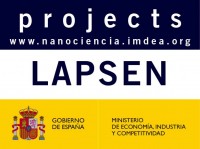LAPSEN Chemical Sensors Based on Dye-Doped Conjugated Polymer Laser Resonators
Prof. Isabel Rodriguez & Dr. Juan Cabanillas
-
Funding :
Ministerio de Economía y Competitividad. Programa Retos de la Sociedad 2013-2016. MAT2014-57652-C2-1-R
-
Duration: 2015 - 2017
-
36 months
In this project we aim at developing chemical sensors based on conjugated polymers (CPs) following a new approach to induce fluorescence transduction signals in the presence of specific analytes using a priori non sensitive CPs. The approach consist of doping CPs with optically-sensitive molecular dyes and make use of a potential Forster resonant energy transfer between both to translate the colorimetric response from the dye into the fluorescent response from the polymer in the presence of toxic gases and volatile organic compounds. Enhanced sensitivity will be subsequently achieved by processing responsive CP/dye blends into laser resonators upon nanostructuring the film surface. We aim at developing a novel strategy to circumvent complex molecular substitution required to achieve high resposivity in pristine CPs. We envisage a combined effort between two different institutions providing the necessary knowledge on photophysics, conjugated polymer photonics, nanostructuring, sensor fabrication and characterization.
http://nanociencia.imdea.org/images/nanociencia/scientific_reports/Scientific-Report-2015.pdf#page=142



